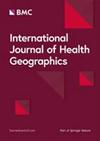Comparison of geographical and individual deprivation index to assess the risk of Sars-CoV-2 infection and disease severity: a retrospective cohort study
IF 3
2区 医学
Q2 PUBLIC, ENVIRONMENTAL & OCCUPATIONAL HEALTH
引用次数: 0
Abstract
It has been shown that COVID-19 affects people at socioeconomic disadvantage more strongly. Previous studies investigating the association between geographical deprivation and COVID-19 outcomes in Italy reported no differences in case-hospitalisation and case-fatality. The objective of this research was to compare the usefulness of the geographic and individual deprivation index (DI) in assessing the associations between individuals' deprivation and risk of Sars-CoV-2 infection and disease severity in the Apulia region from February to December 2020. This was a retrospective cohort study. Participants included individuals tested for SARS-CoV-2 infection during the study period. The individual DI was calculated employing polychoric principal component analysis on four census variables. Multilevel logistic models were used to test associations between COVID-19 outcomes and individual DI, geographical DI, and their interaction. In the study period, 139,807 individuals were tested for COVID-19 and 56,475 (43.5%) tested positive. Among those positive, 7902 (14.0%) have been hospitalised and 2215 (4.2%) died. During the first epidemic wave, according the analysis done with the individual DI, there was a significant inversely proportional trend between the DI and the risk of testing positive. No associations were found between COVID-19 outcomes and geographic DI. During the second wave, associations were found between COVID-19 outcomes and individual DI. No associations were found between the geographic DI and the risk of hospitalisation and death. During both waves, there were no association between COVID-19 outcomes and the interaction between individual and geographical DI. Evidence from this study shows that COVID-19 pandemic has been experienced unequally with a greater burden among the most disadvantaged communities. The results of this study remind us to be cautious about using geographical DI as a proxy of individual social disadvantage because may lead to inaccurate assessments. The geographical DI is often used due to a lack of individual data. However, on the determinants of health and health inequalities, monitoring has to have a central focus. Health inequalities monitoring provides evidence on who is being left behind and informs equity-oriented policies, programmes and practices. Future research and data collection should focus on improving surveillance systems by integrating individual measures of inequalities into national health information systems.比较地理和个人贫困指数以评估 Sars-CoV-2 感染风险和疾病严重程度:一项回顾性队列研究
研究表明,COVID-19 对社会经济处境不利的人群影响更大。此前在意大利进行的关于地理贫困与 COVID-19 结果之间关系的研究报告显示,在病例住院和病死率方面没有差异。这项研究的目的是比较地理和个人贫困指数(DI)在评估 2020 年 2 月至 12 月阿普利亚地区个人贫困程度与 Sars-CoV-2 感染风险和疾病严重程度之间的关联方面的实用性。这是一项回顾性队列研究。参与者包括在研究期间接受过 SARS-CoV-2 感染检测的人。通过对四个普查变量进行多变量主成分分析,计算出个人 DI。多层次逻辑模型用于检验 COVID-19 结果与个人 DI、地域 DI 及其交互作用之间的关联。在研究期间,139807 人接受了 COVID-19 检测,其中 56475 人(43.5%)呈阳性。其中,7902 人(14.0%)住院治疗,2215 人(4.2%)死亡。在第一次流行病浪潮中,根据对个人 DI 的分析,DI 与检测呈阳性的风险之间呈显著的反比趋势。在 COVID-19 结果与地域 DI 之间未发现任何关联。在第二轮调查中,发现 COVID-19 结果与个人 DI 之间存在关联。未发现地域 DI 与住院和死亡风险之间存在关联。在两个波次中,COVID-19 结果与个人和地域 DI 之间的交互作用没有关联。这项研究的证据表明,COVID-19 大流行的影响是不平等的,最弱势的社区承受着更大的负担。这项研究的结果提醒我们,在使用地域 DI 作为个人社会劣势的代表时要谨慎,因为这可能导致评估不准确。由于缺乏个人数据,地域 DI 经常被使用。然而,在健康和健康不平等的决定因素方面,监测必须有一个核心重点。对健康不平等现象的监测为了解哪些人被落在后面提供了证据,并为以公平为导向的政策、计划和实践提供了信息。今后的研究和数据收集工作应侧重于改进监测系统,将对不平等现象的个别衡量纳入国家卫生信息系统。
本文章由计算机程序翻译,如有差异,请以英文原文为准。
求助全文
约1分钟内获得全文
求助全文
来源期刊

International Journal of Health Geographics
PUBLIC, ENVIRONMENTAL & OCCUPATIONAL HEALTH -
CiteScore
10.20
自引率
2.00%
发文量
17
审稿时长
12 weeks
期刊介绍:
A leader among the field, International Journal of Health Geographics is an interdisciplinary, open access journal publishing internationally significant studies of geospatial information systems and science applications in health and healthcare. With an exceptional author satisfaction rate and a quick time to first decision, the journal caters to readers across an array of healthcare disciplines globally.
International Journal of Health Geographics welcomes novel studies in the health and healthcare context spanning from spatial data infrastructure and Web geospatial interoperability research, to research into real-time Geographic Information Systems (GIS)-enabled surveillance services, remote sensing applications, spatial epidemiology, spatio-temporal statistics, internet GIS and cyberspace mapping, participatory GIS and citizen sensing, geospatial big data, healthy smart cities and regions, and geospatial Internet of Things and blockchain.
 求助内容:
求助内容: 应助结果提醒方式:
应助结果提醒方式:


